Day 3 of a three day Private Tour today, our last day. We were planning to head down to the Brecks for the day. It was a nice day today, mostly cloudy but brighter later, lighter winds than of late, and we managed to dodge a couple of quick showers in the afternoon.
As we got down into the northern part of the Brecks, we started to see more pig fields. We stopped by one of them where we could see there was a large mob of gulls. The pig nuts had just been spread out in amongst one group of pigs and the gulls were squabbling in between them trying to help themselves. Then there was a loud ‘Bang!’ as a bird scarer went off and all the gulls took to the air.
When they landed again, down in a dip in the middle of the field, we scanned through the gulls we could see. We had hoped we might find a Caspian Gull, but they were mostly Lesser Black-backed Gulls here today, of various ages, plus a couple of Herring Gulls. We had thought we might come back and have another look here later, but our day ended up taking us off in a different direction.
Stone Curlew was our next target and we quickly found a pair in a field by the road. The vegetation is growing up now and they are getting harder to see, particularly when they sit down. It took a careful scan to find them, but we could just see two heads peeping out. We got them in the scope and could see their staring yellow irises. A nice start to the day.
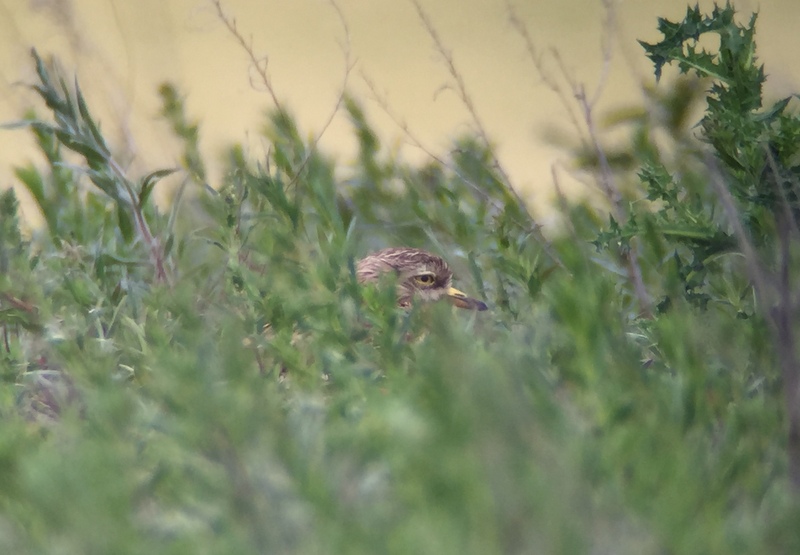 Stone Curlew – one of a pair hiding in the field
Stone Curlew – one of a pair hiding in the field
When originally discussing possible targets for these three days, Wood Warbler was one species which came up. Unfortunately the bird which had been singing near Brandon last week had not been reported for several days, but we wondered whether this might be just because of the windy weather. We went for a quick look just in case, but all was quiet in the trees where it had been, so we didn’t linger here.
Our next stop was more successful. We parked by a ride in the forest and walked along the track until we got to a large clearing. We could hear Goldcrests and a Treecreeper calling in the pines as we passed. As we approached the clearing we could hear a Stonechat calling and we looked over and saw a smart male perched on the top of an old stump row. A female was perched nearby with food in her bill. They clearly had young in the nest nearby.
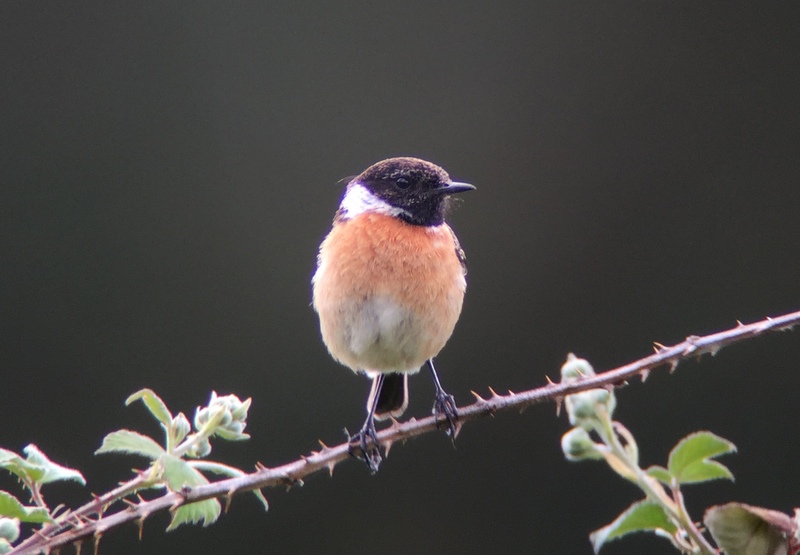 Stonechat – the pair in the clearing appear to have young
Stonechat – the pair in the clearing appear to have young
We were looking for Tree Pipit here and it didn’t take too long to find one. It was perched in the top of an elder tree just along from the Stonechats. We got a good look at it through the scope, swaying about in the wind, before it flew off and up into the pines trees beyond.
 Tree Pipit – perched in an elder tree briefly
Tree Pipit – perched in an elder tree briefly
Continuing on round the clearing, we caught a snatch of song, quite sweet and melodic but more rolling than a Blackcap. It seemed an odd place for a Garden Warbler and the first bird we saw come out of the young pine trees was a Whitethroat which led to a brief bout of head scratching – could we have imagined it? Thankfully, a couple of seconds later the Garden Warbler flicked up into the top of some brambles in the stump row behind, a nice bonus to see here and not one we had expected.
Back to the car and we drove round to another part of the forest. There has been a Redstart singing here recently, but we couldn’t hear it today. Whether it was just busy feeding somewhere out of view or has failed to find a mate and moved on was not clear. A smart male Yellowhammer flew in calling and landed on the fence in front of us.
We had a walk round and flushed a Cuckoo from the grass. It landed on a fencepost briefly, before flying off along the fence line. A second Cuckoo appeared and flew out to a small bush nearby, where we got a great view of it in the scope. Then we heard what we assume was the first Cuckoo singing in the distance, so there were two males here. A little later the second Cuckoo flew over and attempted to chase off the first, before flying back to its favoured bush.
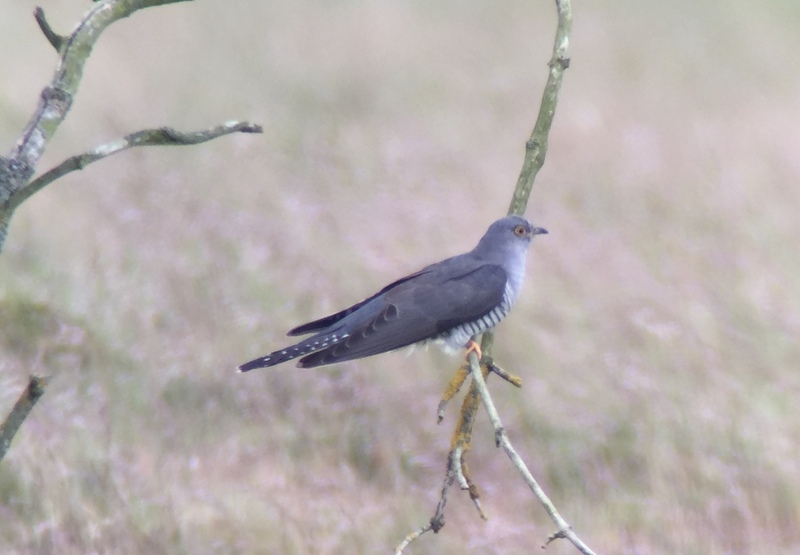 Cuckoo – one of two males here today
Cuckoo – one of two males here today
Another Tree Pipit flew in and dropped down into the long grass. We walked over to try to get a better look at it, but it had managed to sneak away. As we scanned the spot where it had dropped in, the next thing we knew it took off again from further along and flew off towards the trees.
As we turned to walk back, we could hear a Woodlark calling. Suddenly a male Woodlark flew up from a short distance ahead of us and started to sing, fluttering up over our heads, before drifting away over the clearing. We took a few more steps and heard another Woodlark calling. It sounded to be a long way away, but they are masters at throwing their voice and looking at the grass just ahead of us, we spotted it perched on a tussock, presumably the female.
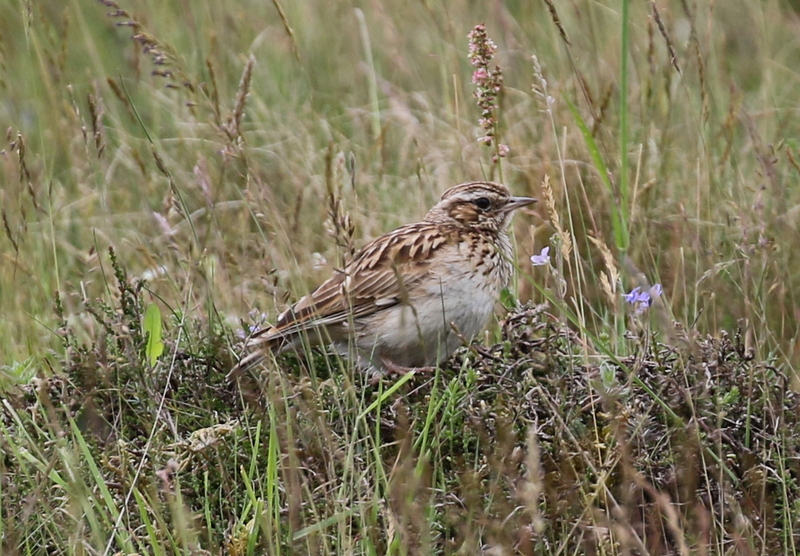 Woodlark – perched on a tussock close to the path
Woodlark – perched on a tussock close to the path
We stopped immediately and had a good look at it through binoculars, but when we tried to get the scope on it, the Woodlark took off and landed in the grass further back, out of view. We headed back to the car and drove on. Having seen Stone Curlew earlier this morning, we were not to worried to see another, but we stopped briefly at Weeting on the way past anyway. We couldn’t find the Stone Curlews here today, but we did find three regular Eurasian Curlews out in the grass, a reminder they still breed in the Brecks in small numbers.
We stopped for lunch at Lakenheath Fen. While we were eating at one of the picnic tables, a Hobby drifted overhead. We had intended to explore the reserve after lunch, but with most of the possible species we might see here already on our list for the three days, another idea sprang to mind. There has been a Red-necked Phalarope at Welney for the last couple of days, which would be a new bird for one of us. It seemed like it would be a great way to round off the trip.
While Welney is not far away as the crow flies, it was a circuitous journey round from Lakenheath, through the Fens. When we arrived at the Welney WWT visitor centre, we could hear Tree Sparrows calling from the bushes outside, but couldn’t see them. We decided to look for them later, and with other things taking priority headed straight out to look for the phalarope. The staff at the visitor centre confirmed it had still been present just a short time ago, so we set off to walk the almost 1km down to Friends Hide.
When we got to the hide, The Red-necked Phalarope was out of view. There were several pairs of Avocets on here and quite a few chicks. A pair of Little Ringed Plovers had a couple of small fluffy juveniles with them too. We had been lucky with the weather today – it was warm and bright as we walked out to the hide – but we had been promised showers in the afternoon and a brief heavy rain shower came through. The adult Avocets and Little Ringed Plovers called to their respective young and sheltered the juveniles under their wings while the rain passed over.
 Avocet – sheltering their chicks under their wings during the rain shower
Avocet – sheltering their chicks under their wings during the rain shower
It quickly brightened up again and the juvenile Avocets and Little Ringed Plovers were let out. The Avocets were being very aggressive. Their idea of childcare is to let the young fend for themselves and chase off potential predators. But they have got their definition of what might be a threat to their young awry – they were busy chasing off anything and everything!
A couple of adult Avocets kept having a go at the poor Little Ringed Plovers, chasing after them while they were trying to protect their young. The adult Little Ringed Plovers tried to lead them away with a distraction display, walking away with wings dangled, trying to look injured. It didn’t really work. The Avocets would follow them at first, then when the Little Ringed Plover felt it had got far enough away, it ran back to its chick but the Avocet simply chased back after it.
 Avocet & Little Ringed Plover – the latter giving a distraction display, feigning injury
Avocet & Little Ringed Plover – the latter giving a distraction display, feigning injury
The Avocets kept chasing the Red-necked Phalarope too, which was probably why it spent so much time hiding in the reeds at the front of the pool. Every time the Red-necked Phalarope swam out, it was promptly chased off. We had a couple of quick views of it. At one point, when chased, it flew across the front of the scrape and landed on a small patch of mud, but the Avocet was still after it and once again it disappeared back into the reeds.
Eventually, the juvenile Avocets moved away from the Red-necked Phalarope’s favoured corner and it managed to swim about for a while feeding out in the open where we could get a good look at it. It was a male, which in phalarope’s means it is the duller plumaged of the sexes, with the females being brighter. The females do all the displaying and leave the males to incubate and rear the young. This male Red-necked Phalarope was still a smart bird, swimming round non-stop, in and out of the reeds, picking at the waters surface for insects of ducking its head under.
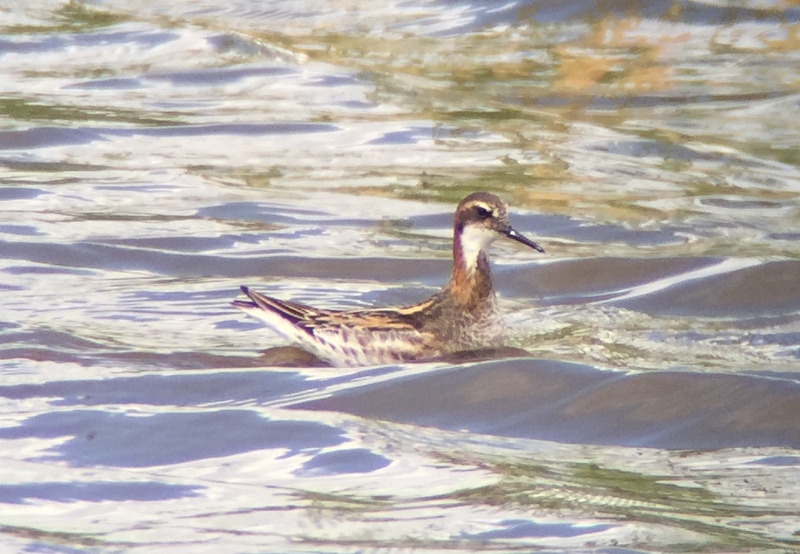 Red-necked Phalarope – swimming around in front of the hide
Red-necked Phalarope – swimming around in front of the hide
We watched the Red-necked Phalarope for a while, swimming once it finally came out into the open for a while. They are rare visitors here and this bird was probably heading up to Scandinavia or Iceland for the breeding season, though where it had spent the winter is anyone’s guess with Scandinavian birds wintering out in the Arabian Sea but recent studies showing that some of the small number of birds breeding in the Shetland Islands migrating to join the North American population in the South Pacific Ocean! When it finally swam back into the reeds again, we decided to start walking back.
On the way back, we stopped for a quick look in the other hides. There did not seem to be too much on view from Lyle Hide, apart from more Avocets – good to see that they appear to be doing so well at Welney. We heard a song that sounded vaguely reminiscent of jangling keys and looked out of the front of the hide to see a Corn Bunting perched on the top of the vegetation. We got a great look at it as it stayed there for a couple of minutes singing, before being spooked by a big flock of Rooks and dropping back down out of view.
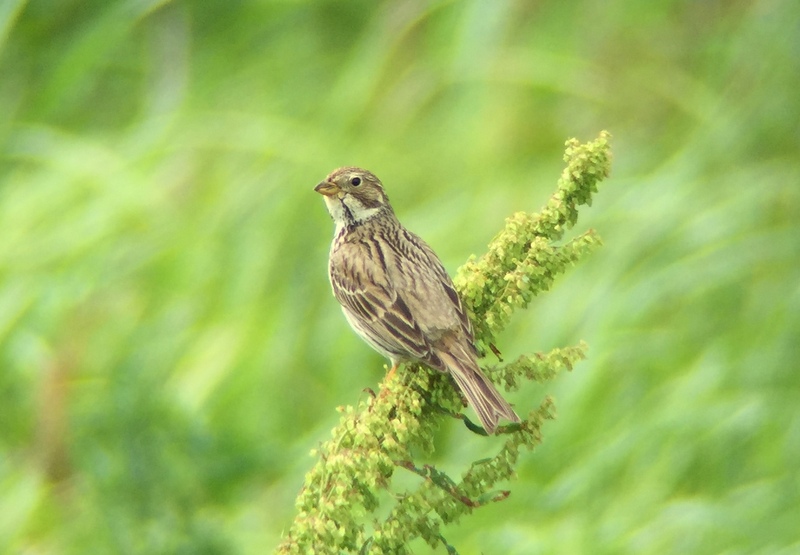 Corn Bunting – singing in front of Lyle Hide
Corn Bunting – singing in front of Lyle Hide
There were several Black-tailed Godwits out to one side of the hide, but the light was bad here as we were looking into the sun. We got better views from the Nelson-Lyle Hide further back. This confirmed our suspicions that they appeared to be a mix of two different races. Nominate limosa or Continental Black-tailed Godwit breeds across Europe east from the Netherlands. Only about 50-60 pairs breed in the UK on the Ouse and Nene Washes, including a couple of pairs at Welney. First summer islandica or Icelandic Black-tailed Godwits often remain in UK in rather than migrate up to Iceland to breed. There appeared to be a mixture of the two here, including a couple of nice limosa, giving us a nice opportunity to compare them.
 Continental Black-tailed Godwit – of the nominate race, limosa
Continental Black-tailed Godwit – of the nominate race, limosa
Back at the Observatory, we could see a pair of Whooper Swans in front of the hide. This is a pair of injured birds which are not capable of flying back up to Iceland to breed, so have instead nested for the last six years at Welney, where they normally spend the winter. We could only see two of the four cygnets they were meant to have this year, but presumed the others were hiding in the vegetation. Further back across the washes we could see another six or so Whooper Swans, presumably also all injured birds.
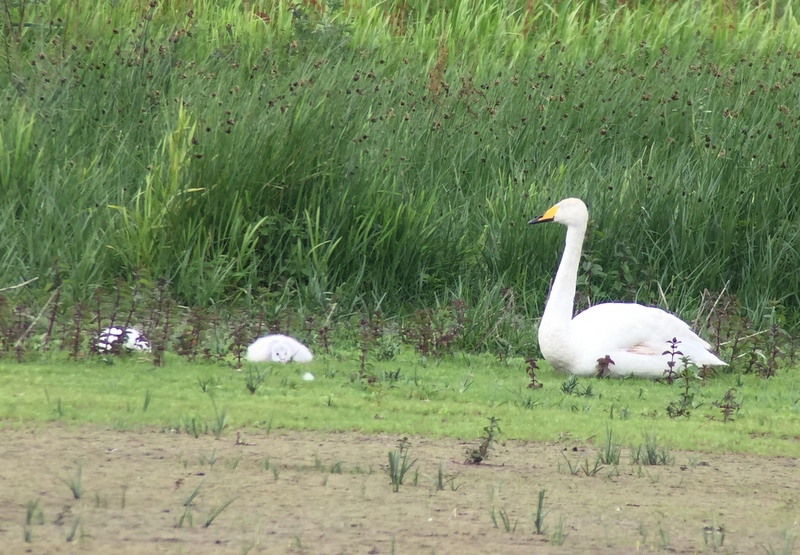 Whooper Swan – with two cygnets
Whooper Swan – with two cygnets
Back at the visitor centre, there were three more Black-tailed Godwits on Lady Fen. A quick look at the feeders as we were leaving finally got us views of the Tree Sparrows, with at least a couple coming and going, including one with only a half-grown tail.
 Tree Sparrow – coming to the feeders in front of the visitor centre
Tree Sparrow – coming to the feeders in front of the visitor centre
It was a lovely way to end three exciting action-packed days of East Anglian summer birding, watching the Red-necked Phalarope and all the other birds at Welney. It rounded off the list nicely – we had managed to see a nice set of rarer birds despite it being early June, as well as a great selection of our resident and scarcer breeding species. A job well done, we set off back for home.
















